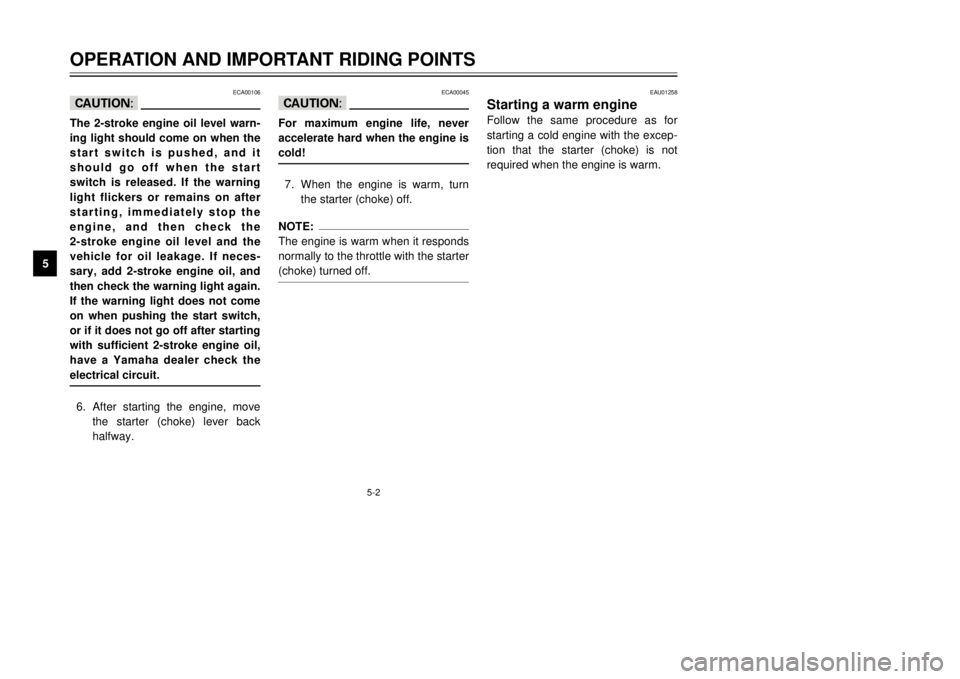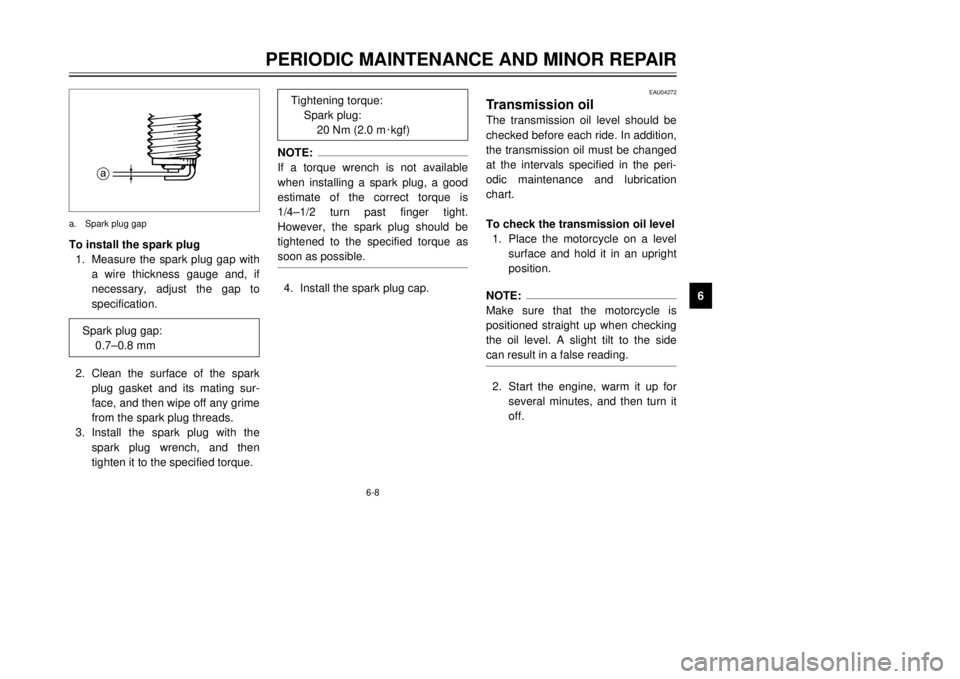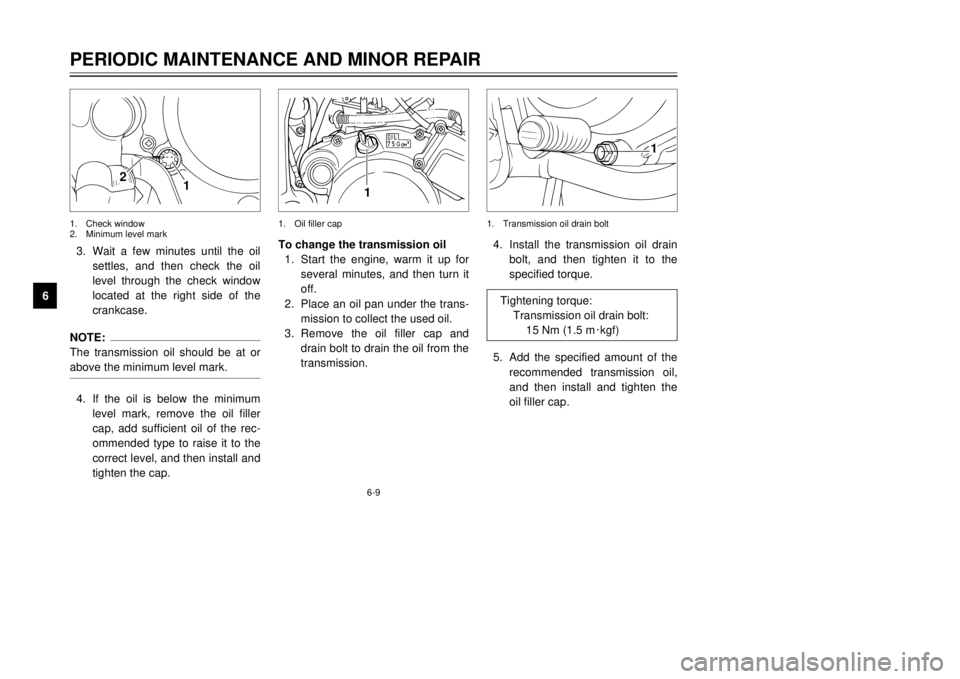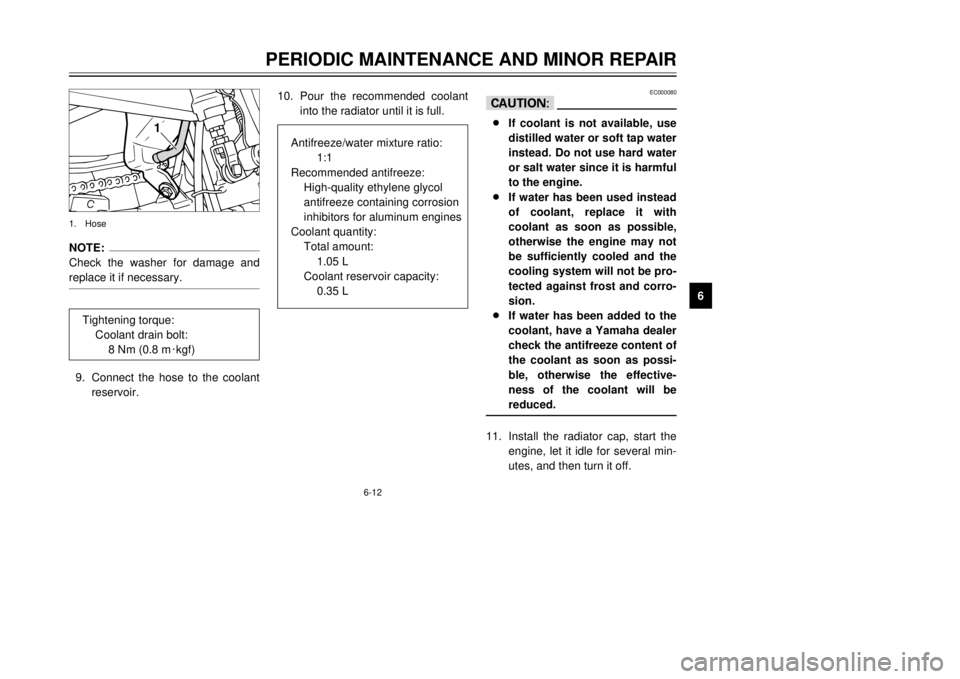Page 33 of 94

5-2
OPERATION AND IMPORTANT RIDING POINTS
5
ECA00106
cCThe 2-stroke engine oil level warn-
ing light should come on when the
start switch is pushed, and it
should go off when the start
switch is released. If the warning
light flickers or remains on after
starting, immediately stop the
engine, and then check the
2-stroke engine oil level and the
vehicle for oil leakage. If neces-
sary, add 2-stroke engine oil, and
then check the warning light again.
If the warning light does not come
on when pushing the start switch,
or if it does not go off after starting
with sufficient 2-stroke engine oil,
have a Yamaha dealer check the
electrical circuit.6. After starting the engine, move
the starter (choke) lever back
halfway.
ECA00045
cCFor maximum engine life, never
accelerate hard when the engine is
cold!7. When the engine is warm, turn
the starter (choke) off.NOTE:
The engine is warm when it responds
normally to the throttle with the starter
(choke) turned off.
EAU01258
Starting a warm engineFollow the same procedure as for
starting a cold engine with the excep-
tion that the starter (choke) is not
required when the engine is warm.
5AE-28199-E5 honbun 7/6/01 10:18 AM Page 32
Page 36 of 94
5-5
OPERATION AND IMPORTANT RIDING POINTS
5 1,000 km and beyond
The vehicle can now be operated
normally.
EC000053
cC8Keep the engine speed out of
the tachometer red zone.
8If any engine trouble should
occur during the engine break-
in period, immediately have a
Yamaha dealer check the vehi-
cle.
EAU00458
ParkingWhen parking, stop the engine,
remove the key from the main switch,
and then turn the fuel cock lever to
“OFF”.
EW000058
w8Since the engine and exhaust
system can become very hot,
park in a place where pedestri-
ans or children are not likely
to touch them.
8Do not park on a slope or on
soft ground, otherwise the
motorcycle may overturn.
EC000062
cCNever park in an area where there
are fire hazards such as grass or
other flammable materials.
5AE-28199-E5 honbun 7/6/01 10:18 AM Page 35
Page 39 of 94

6-3
PERIODIC MAINTENANCE AND MINOR REPAIR
6
9
*Tires•Check tread depth and for damage.
•Replace if necessary.
•Check air pressure.
•Correct if necessary.√√√√ √
10*Wheel bearings•Check bearing for looseness or damage.√√√√
11*Swingarm•Check operation and for excessive play.√√√√
•Lubricate with lithium-soap-based grease. Every 24,000 km
12 Drive chain•Check chain slack.
•Make sure that the rear wheel is properly aligned.
•Clean and lubricate.Every 1,000 km and after washing
the motorcycle or riding in the rain.
13*Steering bearings•Check bearing play and steering for roughness.√√√√√
•Lubricate with lithium-soap-based grease. Every 24,000 km
14*Chassis fasteners•Make sure that all nuts, bolts and screws are properly tightened.√√√√ √
15 Sidestand•Check operation.
•Lubricate.√√√√ √
16*Sidestand switch•Check operation.√√√√√ √
17*Front fork•Check operation and for oil leakage.√√√√
18*Shock absorber
assembly•Check operation and shock absorber for oil leakage.√√√√
19*Carburetor•Check starter (choke) operation.
•Adjust engine idling speed.√√√√√ √
20*Autolube pump•Check operation.
•Bleed if necessary.√√√√ NO. ITEM CHECK OR MAINTENANCE JOBODOMETER READING (× 1,000 km)
ANNUAL
CHECK
1 6 12 18 24
5AE-28199-E5 honbun 7/6/01 10:18 AM Page 38
Page 43 of 94

6-7
PERIODIC MAINTENANCE AND MINOR REPAIR
6
EAU01833
Checking the spark plugThe spark plug is an important
engine component, which is easy to
check. Since heat and deposits will
cause any spark plug to slowly erode,
the spark plug should be removed
and checked in accordance with the
periodic maintenance and lubrication
chart. In addition, the condition of the
spark plug can reveal the condition of
the engine.
To remove the spark plug
1. Remove the spark plug cap.2. Remove the spark plug as
shown, with the spark plug
wrench included in the owner’s
tool kit.To check the spark plug
1. Check that the porcelain insula-
tor around the center electrode
of the spark plug is a medium-to-
light tan (the ideal color when the
motorcycle is ridden normally).
NOTE:
If the spark plug shows a distinctly
different color, the engine could be
defective. Do not attempt to diagnose
such problems yourself. Instead,
have a Yamaha dealer check the
motorcycle.2. Check the spark plug for elec-
trode erosion and excessive car-
bon or other deposits, and
replace it if necessary.
1
1
1. Spark plug cap 1. Spark plug wrench
Specified spark plug:
BR9ES (NGK)
5AE-28199-E5 honbun 7/6/01 10:18 AM Page 42
Page 44 of 94

6-8
PERIODIC MAINTENANCE AND MINOR REPAIR
6 To install the spark plug
1. Measure the spark plug gap with
a wire thickness gauge and, if
necessary, adjust the gap to
specification.
2. Clean the surface of the spark
plug gasket and its mating sur-
face, and then wipe off any grime
from the spark plug threads.
3. Install the spark plug with the
spark plug wrench, and then
tighten it to the specified torque.
NOTE:
If a torque wrench is not available
when installing a spark plug, a good
estimate of the correct torque is
1/4–1/2 turn past finger tight.
However, the spark plug should be
tightened to the specified torque as
soon as possible.4. Install the spark plug cap.
EAU04272
Transmission oil
Transmission oil
The transmission oil level should be
checked before each ride. In addition,
the transmission oil must be changed
at the intervals specified in the peri-
odic maintenance and lubrication
chart.
To check the transmission oil level
1. Place the motorcycle on a level
surface and hold it in an upright
position.NOTE:
Make sure that the motorcycle is
positioned straight up when checking
the oil level. A slight tilt to the side
can result in a false reading.2. Start the engine, warm it up for
several minutes, and then turn it
off.
a
a. Spark plug gap
Spark plug gap:
0.7–0.8 mm
Tightening torque:
Spark plug:
20 Nm (2.0 m0kgf)
5AE-28199-E5 honbun 7/6/01 10:18 AM Page 43
Page 45 of 94

6-9
PERIODIC MAINTENANCE AND MINOR REPAIR
63. Wait a few minutes until the oil
settles, and then check the oil
level through the check window
located at the right side of the
crankcase.
NOTE:
The transmission oil should be at or
above the minimum level mark.4. If the oil is below the minimum
level mark, remove the oil filler
cap, add sufficient oil of the rec-
ommended type to raise it to the
correct level, and then install and
tighten the cap.To change the transmission oil
1. Start the engine, warm it up for
several minutes, and then turn it
off.
2. Place an oil pan under the trans-
mission to collect the used oil.
3. Remove the oil filler cap and
drain bolt to drain the oil from the
transmission.4. Install the transmission oil drain
bolt, and then tighten it to the
specified torque.
5. Add the specified amount of the
recommended transmission oil,
and then install and tighten the
oil filler cap.
1
2
1
1
1. Check window
2. Minimum level mark1. Oil filler cap 1. Transmission oil drain bolt
Tightening torque:
Transmission oil drain bolt:
15 Nm (1.5 m0kgf)
5AE-28199-E5 honbun 7/6/01 10:18 AM Page 44
Page 46 of 94

6-10
PERIODIC MAINTENANCE AND MINOR REPAIR
6
EC000077
cC8In order to prevent clutch slip-
page (since the transmission
oil also lubricates the clutch),
do not mix any chemical addi-
tives with the oil.
8Make sure that no foreign
material enters the transmis-
sion.6. Start the engine, and then let it
idle for several minutes while
checking the transmission for oil
leakage. If oil is leaking, immedi-
ately turn off the engine and
check for the cause.
EAU03761
CoolantTo check the coolant level
1. Place the motorcycle on a level
surface and hold it in an upright
position.NOTE:
8The coolant level must be
checked on a cold engine since
the level varies with engine tem-
perature.
8Make sure that the motorcycle is
positioned straight up when
checking the coolant level. A
slight tilt to the side can result in
a false reading.
2. Check the coolant level in the
coolant reservoir.NOTE:
The coolant should be between the
minimum and maximum level marks.3. If the coolant is at or below the
minimum level mark, open the
reservoir cap, add coolant to the
maximum level mark, and then
close the reservoir cap.
1
2
1. Maximum level mark
2. Minimum level mark
Recommended transmission oil:
See page 8-1.
Oil quantity:
Periodic oil change:
0.75 L
Total amount (dry transmission):
0.8 L
5AE-28199-E5 honbun 7/6/01 10:18 AM Page 45
Page 48 of 94

6-12
PERIODIC MAINTENANCE AND MINOR REPAIR
6
NOTE:
Check the washer for damage and
replace it if necessary.9. Connect the hose to the coolant
reservoir.10. Pour the recommended coolant
into the radiator until it is full.
EC000080
cC8If coolant is not available, use
distilled water or soft tap water
instead. Do not use hard water
or salt water since it is harmful
to the engine.
8If water has been used instead
of coolant, replace it with
coolant as soon as possible,
otherwise the engine may not
be sufficiently cooled and the
cooling system will not be pro-
tected against frost and corro-
sion.
8If water has been added to the
coolant, have a Yamaha dealer
check the antifreeze content of
the coolant as soon as possi-
ble, otherwise the effective-
ness of the coolant will be
reduced.11. Install the radiator cap, start the
engine, let it idle for several min-
utes, and then turn it off.
1
1. Hose
Tightening torque:
Coolant drain bolt:
8 Nm (0.8 m0kgf)
Antifreeze/water mixture ratio:
1:1
Recommended antifreeze:
High-quality ethylene glycol
antifreeze containing corrosion
inhibitors for aluminum engines
Coolant quantity:
Total amount:
1.05 L
Coolant reservoir capacity:
0.35 L
5AE-28199-E5 honbun 7/6/01 10:18 AM Page 47